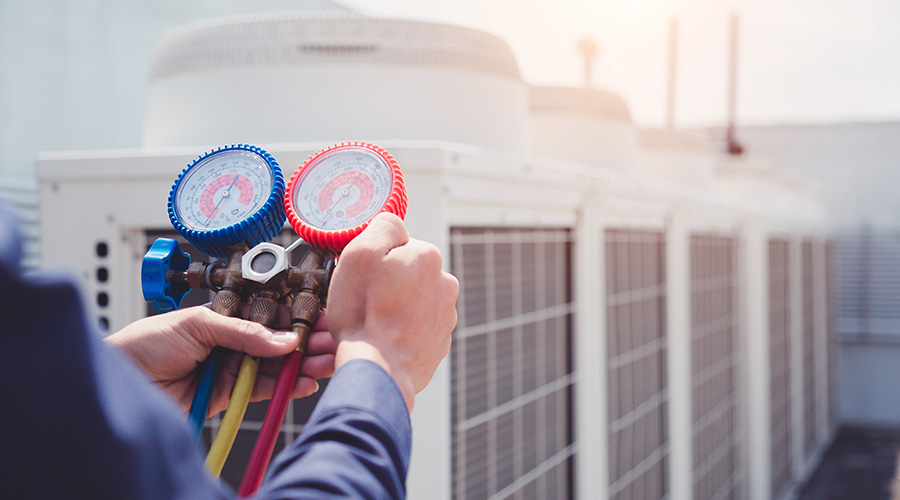The Higher the MERV the Better: With Some Exceptions
MERV 13 filters can boost a facility's IAQ, but are systems equipped to handle them?
By Dave Lubach, Executive Editor
Many of the developments that unfolded for maintenance and engineering managers during the COVID-19 pandemic still impact institutional and commercial facilities today.
One of the more vital facilities issues to emerge from the pandemic was increased interest in indoor air quality (IAQ) — specifically, ventilation and air filtration. Before the pandemic, building occupants were typically only concerned if building temperatures were too hot or too cold. Suddenly, parents were worried about the air quality in their children’s schools, and office employees wanted assurance that their workplace indoor air was healthy.
“The quality of the air that goes through a filter was never a discussion that we had prior to 2020,” says Kevin Delahunt, a senior technical advisor for the National Air Filtration Association. “We’ve evolved from being a mechanical discipline, that sort of thing, to one now of health and safety.”
MERV matters
Delahunt has worked in the air filtration industry for more than 30 years. His educational session at the AHR Expo focused on the importance of matching systems with air filters to achieve maximum efficiency rating value (MERV).
The higher the MERV rating, the cleaner the air pushing through the filter. Filters with MERV ratings of 5-12 are considered medium efficiency and serve as a mechanical filter designed to keep system equipment clean. Before the pandemic, most facilities used MERV 6 or MERV 8 filters.
Due to the circumstances surrounding the pandemic, facilities turned to filters rated MERV 13-16, which are designed to emphasize occupant health and comfort.
Most managers were about to improve their facilities’ IAQ by upgrading air filters.
“As soon as you do something to your system, such as upgrade a filter or something to the integrity of a filter, it’s an immediate positive result,” Delahunt says. “If I go from a MERV 8 to a MERV 13, I go from a particle penetration from 80 percent down to 20 percent. That’s an amazing result and a quick response to it.”
Improving IAQ is not always that easy. While swapping out filters for a more efficient option seems like a no-brainer, managers need to consider several factors before making the switch.
First, managers need to consider costs. Delahunt says a MERV 15 filter can cost up to $125 each, while MERV 8s cost closer to $8.
Many managers also forgot that in the haste to upgrade their filters and assure occupants that the air they are breathing is healthy, they did not consider if their HVAC systems could handle the stronger filters.
“During COVID, the responses were, ‘I’ve got to put MERV 13 in it,’” Delahunt says. “We’ve seen, especially with school boards, that they want to put MERV 13s in a unit that probably at best had a MERV 6 capability. The average age of an HVAC system is probably about 38 and a half years old, so it’s putting the proverbial lipstick on a pig.”
Delahunt says managers need to be sure their systems can handle the increased pressure of operating with the new filters, which also must be fitted to achieve maximum efficiency.
“If it doesn’t fit, it doesn’t filter,” he says. “It’s that simple. If the air isn’t going 100 percent through the filter, you don’t have the filter efficiency you think you’re doing. Air will always take the path of least resistance. The more efficient the filter, the more the air is going to want to bypass it. If you don’t a have fit, you’ve wasted your money on a MERV 13 system.”
Beyond the pandemic
Many managers seem to have moved on from reacting to the pandemic, but IAQ and air filtration remain a priority for facilities.
“COVID, for the most part, seems to be in their rearview mirror,” says Laurie Gilmer, vice-president and COO of Facility Engineering Associates.
As priorities change and organizations emphasize health and wellness, many IAQ discussions have transitioned to protecting building occupants from such dangers as wildfire smoke.
While wildfires have always been a concern for certain parts of the country, such as California, during the summer of 2023, Canadian wildfires spiked unhealthy air quality levels across the United States. Images from New York City showed thick levels of smoke, and other northern parts of the country often spent otherwise clear days under clouds of smoke.
Meteorologists are predicting fewer wildfires in 2024, but the massive clouds of smoke that accumulated across North American cities last summer can serve as warning signs of the challenges that lie ahead.
Gilmer says managers can focus on a particulate matter amount of 2.5 micrometers when measuring dangerous air quality levels. Enough exposure to even those smallest size of particles — the average human hair is 70 micrometers in diameter — can induce tissue and lung inflammation in humans and lead to health problems that include asthma and heart disease.
“It was the Canadian fires where we had particulate matter traveling so far that I think people were caught off guard and perhaps off COVID were more sensitive to what we might be breathing, compared to 10 to 20 years ago we wouldn’t have thought about it,” Gilmer says.
Bottom-line considerations
Due to federal funding options such as the Inflation Reduction Act and several school initiatives offered by the U.S. Department of Energy, now is a good time for facilities to address their HVAC systems and IAQ challenges.
“It’s unprecedented right now,” Delahunt says.
Matching new filters with existing technology can be challenging, so managers might want to take advantage of the federal funding opportunities to upgrade HVAC systems. Some systems in facilities are 50 years old and even older, so it can be difficult to match them with new-generation filters.
“Throwing in a good filter in bad housing, that doesn’t really do you a lot of favors,” he says.
As the pandemic fades as a top priority in facilities, managers need to maintain healthy levels of IAQ.
“I think what we’ve retained from the pandemic is that better filtration is a good thing to keep our eyes on and that we’re probably more sensitive to when we hear about things like the pollen count or fires,” Gilmer says.
Dave Lubach is the executive editor for the facilities market. He has more than nine years of experience reporting on facilities. management and maintenance issues.
Related Topics:












